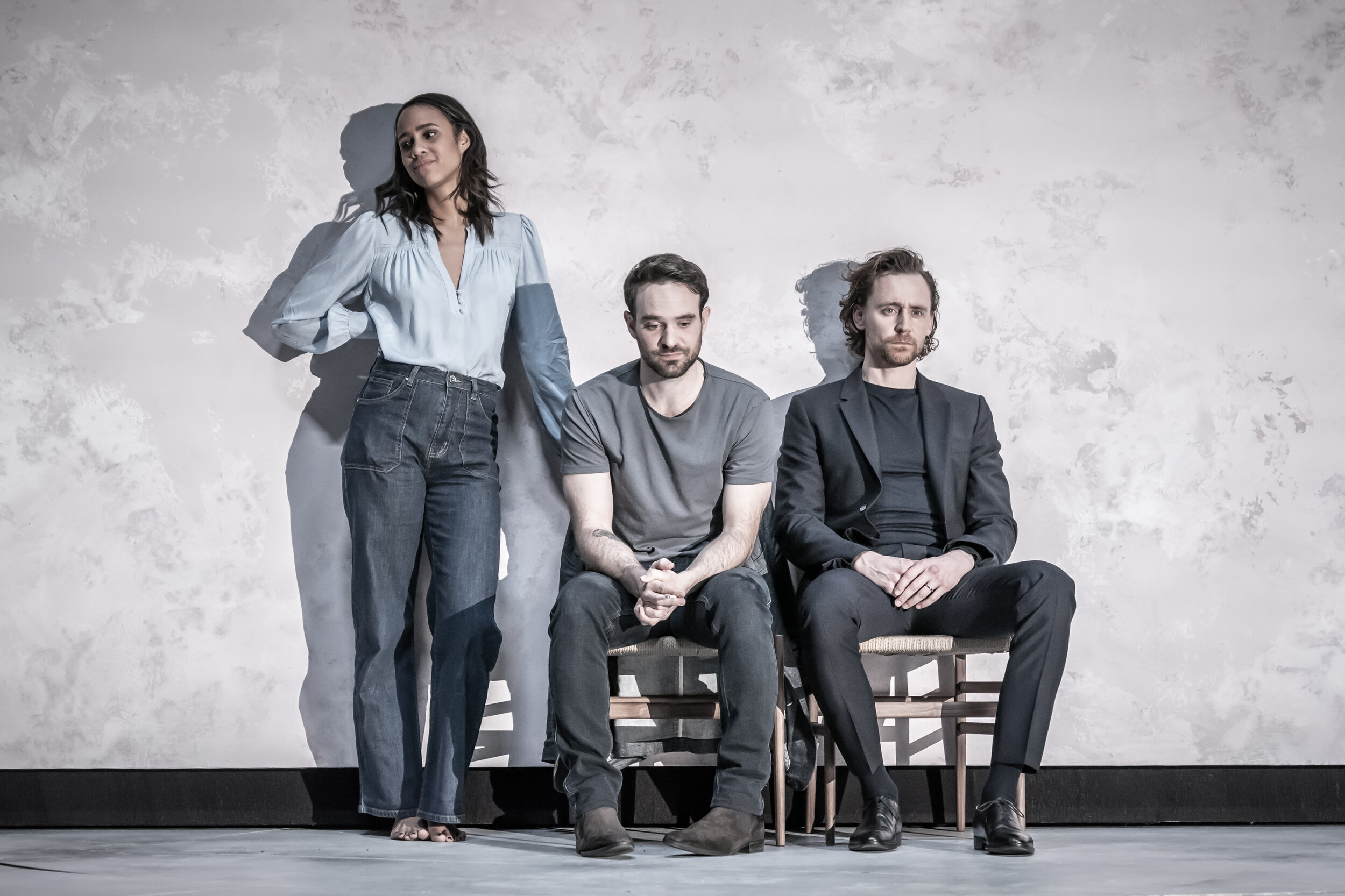REVIEW: Tom Hiddleston in “Betrayal”
Zawe Ashton, Charlie Cox, and Tom Hiddleston in “Betrayal”. Photo Credit: Marc Brenner.
Nobel Prize-winning playwright Harold Pinter’s 1978 play “Betrayal” is considered among his greatest (if not most accessible), despite the fact that its Broadway bow in 1980, starring Blythe Danner, Raúl Julia, and Roy Scheider no less, received only two Tony Award nominations—neither of them for best play—and ran a mere five months.
Something of a “Betrayal” renaissance has occurred this century, though, with three major Broadway revivals in just 19 years. David Leveaux’s production for the Roundabout Theatre Company in 2000 starred Juliette Binoche, Liev Schreiber, and John Slattery. A box-office breaking take by director Mike Nichols in 2013 starred real-life married couple Daniel Craig and Rachel Weisz as the married couple at the center of the plot.
And now, just six years later, “Betrayal” is back on the boards with director Jamie Lloyd’s hit London production that was the culmination of “Pinter at the Pinter”—an unprecedented season of Harold Pinter’s work shown at the theatre bearing his name on the West End and marking ten years since the acclaimed dramatist’s death.
Inspired by Pinter’s own seven-year extramarital affair with BBC presenter Joan Bakewell in the 1960s, “Betrayal” is about an affair between gallerist Emma (Zawe Ashton) and literary agent Jerry (Charlie Cox), the best friend of Emma’s husband, Robert (Tom Hiddleston), and best man at their wedding. Over nine short scenes in 90 minutes, a myriad of betrayals among the three are revealed.
Among the more intriguing conventions of the play is Pinter’s use of reverse chronology, telling the story from the end to the beginning of the affair, as a way to unpack the relationships and reveal the dishonesties and deceptions—both large and small, internal and external—of the characters.
This non-contextual production, presumably set in the present, features a bare stage bounded by gray walls on three sides and the use of a handful of chairs as furniture; muted costumes in monochromes of gray and blue (set and costume design by Soutra Gilmour) combine with the simplicity of the setting to draw focus to the performances and Pinter’s words themselves.
Charlie Cox, Zawe Ashton, and Tom Hiddleston in “Betrayal”. Photo Credit: Marc Brenner.
Often laboriously sedentary staging is upended by the superfluous use of turnstiles in scene transitions that make for fleeting tableaus that are more visually than dramatically successful. The use of an uncredited child to pantomime a memory alluded to by the characters is equally as unnecessary and masturbatory.
Mr. Lloyd keeps all three actors in the triangle on stage for the entirety of the play, such that the character not participating in any given scene becomes a silent observer to the drama unfolding—one that hinges almost entirely on what knowledge each character possesses of the others’ transgressions. This choice, above all, is the most chilling and effective.
Mr. Hiddleston is both the marquee and literal star of this otherwise underwhelming and clinical staging. A classically trained actor perhaps best known for his film work in the Avengers series, Mr. Hiddleston gives an intensely magnetic performance that is both gripping and satisfying. Ms. Ashton effortlessly matches Mr. Hiddleston’s presence and elegance, but Mr. Cox appears to be in an entirely different play altogether, as does Eddie Arnold, who plays a near-scene-stealing Venetian waiter who reads like he walked off the set of a Mack Sennett slapstick. All four actors are making their Broadway debuts.
“Betrayal” is a drama that typically sears and smolders, so I was surprised and distracted by the uproarious laughter at the performance I attended, most of it the product of Mr. Cox’s befuddled characterization of Jerry. Such a play for humor, especially in the opening scenes, denudes the story of the seriousness upon which its drama hangs, otherwise the play descends into a silly and insignificant farce about sexual dalliances among a group of upper-class intellectuals.
It is easy to see the appeal of “Betrayal”. The text is pure gold, dream material blessed with taut and sparse dialogue and a foundation overflowing with subtext that affords an actor a chance to flex some muscles in a focused showcase. The play is also a producer’s dream: a four-person drama by a famed playwright that is the ideal vehicle for box office-drawing movie stars and doesn’t require much in terms of production values.
I have only seen the play twice now, and it is far from being a favorite, but the current production on Broadway strikes me as pretentiously unadorned and wholly unremarkable. I didn’t much care for the 2013 production, either, so I will just have to wait for the next one in, say, 2025.
Bottom Line: Tom Hiddleston’s magnetic and gripping performance is the reason to see this otherwise pretentiously unadorned and wholly unremarkable production of Harold Pinter’s “Betrayal”—the third major revival on Broadway in just 19 years. The text is gold but this muted and non-contextual production does not do it justice.
_______________
“Betrayal”
Bernard Jacobs Theatre
242 West 45th Street
New York, NY 10036
Opening Night: September 5, 2019
Final Performance: December 8, 2019
Discount Tickets


